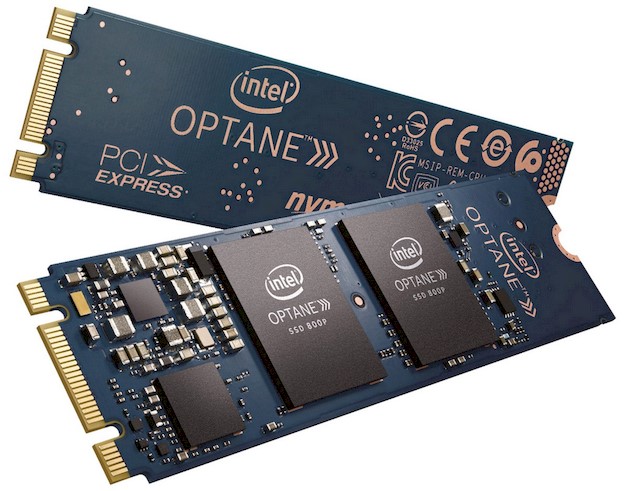Intel Optane SSD 800P Review: A Speedy M.2 Solid State Drive With 3D XPoint For The Masses
Intel Optane SSD 800P - All You Need To Know
Intel is launching its latest Optane-branded family of solid state drives today, the Intel Optane SSD 800P. Unlike the Intel Optane Memory devices, which accelerate hybrid storage configurations through intelligent data caching, or the Optane SSD 900P that’s aimed squarely at hardcore enthusiasts with big budgets, the Intel Optane 800P targets the meat of the mobile and desktops markets, with higher capacities than Optane Memory, but much more affordable pricing than the 900P.
The Intel Optane SSD 800P can technically be used as a data caching accelerator like Optane Memory, but these drives are designed to be used as boot volumes to boost performance of mainstream systems. When you look at their specifications, however, you may wonder where the Intel Optane SSD 800P fits in a market where NVMe M.2 gumsticks offering >3GB/s of throughput are increasingly more commonplace. Rest assured, the Intel Optane SSD 800P performs well with the day-to-day computing workloads that matter most for the majority of consumer user cases.
Let’s dive in and break things down...

Find Intel Optane SSD 800P Series Drives @ Amazon.Com
The Intel Optane SSD 800P can technically be used as a data caching accelerator like Optane Memory, but these drives are designed to be used as boot volumes to boost performance of mainstream systems. When you look at their specifications, however, you may wonder where the Intel Optane SSD 800P fits in a market where NVMe M.2 gumsticks offering >3GB/s of throughput are increasingly more commonplace. Rest assured, the Intel Optane SSD 800P performs well with the day-to-day computing workloads that matter most for the majority of consumer user cases.
Let’s dive in and break things down...
|

Find Intel Optane SSD 800P Series Drives @ Amazon.Com
The initial two drives in the Intel Optane SSD 800P line-up will come in capacities of 58GB and 118GB – not terribly large, but enough to be the boot volume in a modem Windows 10-based system, provided some additional storage is also available for applications and bulk storage.
The drives utilize the M.2 2280 form factor and are rated for sequential reads and writes of 1.4GB/s and 600MB/s, respectively, over their PCIe 3.0 x2 interfaces. Those numbers will seem low in light of many other M.2 NVMe SSD that use 4 lanes of PCIe connectivity and offer peak transfers in excess of 3GB/s, but the Optane SSD 800P is all about low latency and achieving high performance with 4K transfers at low queue depths. Super-fast large, sequential transfers were not a priority here – more on this later.
Random 4K read/write IOPs are rated at 340K/140K and the drives offer endurance ratings of 200GB of writes per day (over 5 years), or 365 TBW (terabytes written). Power is also relatively low at only 8mW while idle and 3.75W under load. Like many of Intel’s other solid state drives, the Optane SSD 800P family also carries a full 5 year warranty.
At the heart of these drives is an Intel-built controller and a couple of pieces of 3D XPoint Memory. Intel hasn’t revealed much about the controller architecture, but we have detailed 3D XPoint a few times in the past. We’ll explain what makes 3D XPoint different compared to traditional NAND on the next page, but to quickly summarize, it is a relatively new memory technology that offers performance and latency characteristics approaching DRAM, but at capacities and prices closer to NAND flash memory. 3D XPoint is also non-volatile like NAND.
The drives utilize the M.2 2280 form factor and are rated for sequential reads and writes of 1.4GB/s and 600MB/s, respectively, over their PCIe 3.0 x2 interfaces. Those numbers will seem low in light of many other M.2 NVMe SSD that use 4 lanes of PCIe connectivity and offer peak transfers in excess of 3GB/s, but the Optane SSD 800P is all about low latency and achieving high performance with 4K transfers at low queue depths. Super-fast large, sequential transfers were not a priority here – more on this later.
Random 4K read/write IOPs are rated at 340K/140K and the drives offer endurance ratings of 200GB of writes per day (over 5 years), or 365 TBW (terabytes written). Power is also relatively low at only 8mW while idle and 3.75W under load. Like many of Intel’s other solid state drives, the Optane SSD 800P family also carries a full 5 year warranty.
At the heart of these drives is an Intel-built controller and a couple of pieces of 3D XPoint Memory. Intel hasn’t revealed much about the controller architecture, but we have detailed 3D XPoint a few times in the past. We’ll explain what makes 3D XPoint different compared to traditional NAND on the next page, but to quickly summarize, it is a relatively new memory technology that offers performance and latency characteristics approaching DRAM, but at capacities and prices closer to NAND flash memory. 3D XPoint is also non-volatile like NAND.







